Epidemiological situation of HPAI viruses from clade 2.3.4.4 in Europe (situation as of 9th January 2018): circulation of a new H5N6 strain
For the Epidemic Intelligence team (VSI) (in alphabetical order): Anne Bronner (DGAL), Didier Calavas (ANSES), Julien Cauchard (ANSES), Sylvain Falala (INRA), Alizé Mercier (CIRAD)
For the National Hunting and Wildlife Agency (ONCFS): Anne Van De Wiele
Corresponding author: alize.mercier@cirad.fr
This is the translated version of the report posted in French on 11th January (link).
Sources: Data updated on 9th January 2018 (included) ADNS/FAO/OIE, DGAL (General Directorate of Food – French Ministry of Agriculture), ProMED, media (Avian Flu Diary)
Since the last situation report on 5th December 2017, a new highly pathogenic avian influenza (HPAI) virus of subtype H5N6 has been identified in Europe, affecting the Netherlands, Germany, Switzerland and the United Kingdom (Figure 1, Table 1). This reassortant virus is different from the H5N6 zoonotic strain that has been circulating in Asia for the past few years, and is the result of a recombination between the highly pathogenic (HP) H5N8 virus that circulated in Europe in 2016-2017 and a low pathogenic (LP) Eurasian strain.
From 1st October 2017 to 9th January 2018 (included), a total of 63 outbreaks of HPAI H5 were notified in seven European countries: Italy, Bulgaria, Cyprus, Germany, the Netherlands, Switzerland and the United-Kingdom (Table 1, Figure 1). Two serotypes were identified: H5N8 and H5N6.
Figure 1. Map of HPAI H5 outbreaks and cases notified in Europe from 1st October 2017 to 9th January 2018 included (source: ADNS)
Table 1: Number of outbreaks in domestic, wild and captive birds notified in Europe from 1st October 2017 to 9th January 2018 by serotype and type of species (source: ADNS)
SEVERAL WILDLIFE SPECIES AND SECTORS OF THE POULTRY INDUSTRY AFFECTED SINCE 1ST OCTOBER 2017
The HPAI H5 outbreaks has affected several sectors of the poultry industry, including fattening turkeys, ducks, geese, laying hens and chickens, in both commercial and backyard farms.
In wildlife, the virus has infected several species:
- a common buzzard (Buteo buteo) – Cyprus,
- wild ducks – Germany,
- a wild goose (species undetermined), a common krestel (Falco tinnunculus) and a rock pigeon (Columba livia) – Italy, and
- mute swans (Cygnus olor) – the Netherlands, Switzerland, Italy and the United Kingdom.
The rock pigeon belongs to the Columbidae family, which is in general though to be less susceptible to avian influenza strains. The only cases of HPAI H5N8 detected in Columbidae in the world were located in the South-West of France (two common wood pigeons and five turtledoves), in direct link with the affected farms, with the hypothesis of a particularly high viral load developed in the affected poultry farms. This hypothesis is also valid for Italy. The list of wild species at risk in Europe has been published in the EFSA journal ((link is external)Scientific opinion, accepted 14th September 2017, doi: 10.2903/j.efsa.2017.4991).
Although large bird migrations are now over in Europe, bird movements within Europe may still occur.
A H5N2 VIRUS DETECTED IN RUSSIA
On 29th December 2017, Russia reported an outbreak of HPAI H5N2 in a poultry farm of more than 660 000 birds, in the region of Kostroma in the Northeast of Moscow (OIE report 29/12/2017). This outbreak was initially notified as H5N8 three days prior.
This is the first report of HPAI H5N2 virus in Russia and the last outbreak of HPAI H5N2 reported in Europe dates back to January 2017 with three outbreaks reported in poultry farms in France.
Regarding the origin of this virus, two hypotheses can be formulated:
- the mutation of a LP H5N2 virus in domestic birds, into a HP virus (as was the case in 2015 with H7N7 in the United Kingdom and Germany, or with H5N1 and H5N2 in France),
- a reassortment between HP H5N8 which circulated in Europe in 2016-2017 with a LP Eurasian strain, as for the H5N6 virus currently circulating in Europe. Indeed, viruses from clade 2.3.4.4 have a strong mutation potential, as illustrated by the emergence of H5N6 and H5N5 viruses following the circulation of H5N8 in Europe in 2016-2017.
Whatever the case may be, further analyses are needed to identify the origin, the link and the genetic composition of these new viruses, and the evolution of the epidemiological situation in Europe should be closely monitored.


